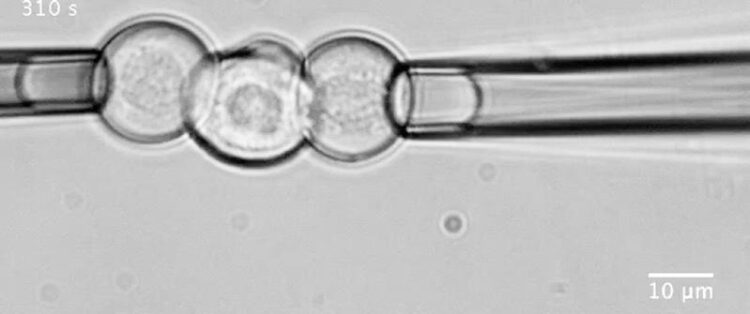Sticking together

Determination of neural progenitor cell-cell de-adhesion forces using micropipette aspiration / IST Austria
In unraveling how a single cell develops into a complex organism, one vexing question has remained for developmental biology: How do robust patterns form in the body? An answer has now been found for the zebrafish neural tube. In this paradigm of patterned tissues, the varying stickiness of cells combined with gradients of signaling molecules is responsible for generating a robust pattern. This is the result of a study published in Science, carried out jointly by the lab of Carl-Philipp Heisenberg at the Institute of Science and Technology Austria (IST Austria) and the lab of Sean Megason at Harvard Medical School.
Adhesion, the missing piece
Going from the ventral to the dorsal side, the neural tube, the precursor to the central nervous system, is strikingly organized into domains of cells with different identities and fates. One hypothesis for how this pattern is created is the so-called French Flag model. According to this hypothesis, a signaling molecule sets up a gradient across a field of cells, and a cell “knows” its location within the field, and consequently its identity, by the amount of signaling molecule it receives.
However, cells move around as an organism develops, disrupting the strict division into domains. An additional mechanism is needed to maintain the domains. Combining a range of genetic, developmental and biophysical experiments, the groups of Carl-Philipp Heisenberg and Sean Megason, with first author Tony Tsai carrying out experiments in both labs, have been able to solve the puzzle: Adhesion, or the “stickiness” of cells, is the factor that keeps cells of the same domain together, and cells of different domains apart.
Differences in binding induce cell sorting
The Heisenberg lab at IST Austria has developed several biophysical tools with which they can test how strongly cells stick together – for example, by measuring how much force is needed to pull cells apart. Applying this to cells from the zebrafish neural tube, the researchers found that cells belonging to the same domain stick together tightly, while cells from different domains are more easily separated. “This difference in the binding force can induce sorting processes”, explains Heisenberg.
The difference in “stickiness” corresponds with a differential expression of adhesion proteins in the domains, the researchers further found. The different cell types express different classes of cadherins: N-cadherin, Cadherin 11, and Protocadherin 19. When the researchers interfere with this expression, making cells express more or less of a certain cadherin, preferential adhesion and correct cell sorting are lost.
“Our experiments show that a sorting process based on adhesion, together with a gradient of the signaling molecule Sonic Hedgehog, leads to a precise sorting of cells into domains based on their cell type”, concludes Heisenberg. “By combining experiments from biophysics, genetics, and developmental biology, we were able to successfully solve this long-standing question.”
Originalpublikation:
2020. Tony Y-C. Tsai, Mateusz Sikora, Peng Xia, Tugba Colak-Champollion, Holger Knaut, Carl-Philipp Heisenberg, Sean G. Megason. An adhesion code ensures robust pattern formation during tissue morphogenesis. Science. DOI: 10.1126/science.aba6637
Media Contact
All latest news from the category: Life Sciences and Chemistry
Articles and reports from the Life Sciences and chemistry area deal with applied and basic research into modern biology, chemistry and human medicine.
Valuable information can be found on a range of life sciences fields including bacteriology, biochemistry, bionics, bioinformatics, biophysics, biotechnology, genetics, geobotany, human biology, marine biology, microbiology, molecular biology, cellular biology, zoology, bioinorganic chemistry, microchemistry and environmental chemistry.
Newest articles

You are What You Eat—Stanford Study Links Fiber to Anti-Cancer Gene Modulation
The Fiber Gap: A Growing Concern in American Diets Fiber is well known to be an important part of a healthy diet, yet less than 10% of Americans eat the minimum recommended…

Trust Your Gut—RNA-Protein Discovery for Better Immunity
HIRI researchers uncover control mechanisms of polysaccharide utilization in Bacteroides thetaiotaomicron. Researchers at the Helmholtz Institute for RNA-based Infection Research (HIRI) and the Julius-Maximilians-Universität (JMU) in Würzburg have identified a…

ASXL1 Mutation: The Hidden Trigger Behind Blood Cancers and Inflammation
Scientists show how a mutated gene harms red and white blood cells. LA JOLLA, CA—Scientists at La Jolla Institute for Immunology (LJI) have discovered how a mutated gene kicks off…



